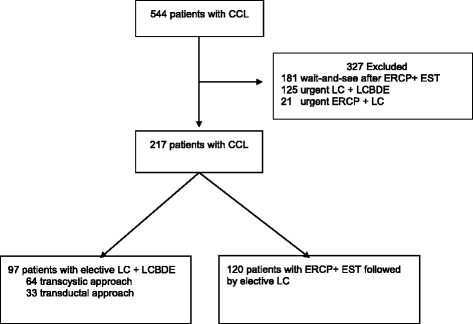Cost-analysis and effectiveness of one-stage laparoscopic versus two-stage endolaparoscopic management of cholecystocholedocholithiasis: a retrospective cohort study
- PMID: 28683735
- PMCID: PMC5501265
- DOI: 10.1186/s12893-017-0274-2
Cost-analysis and effectiveness of one-stage laparoscopic versus two-stage endolaparoscopic management of cholecystocholedocholithiasis: a retrospective cohort study
Abstract
Background: One-stage laparoscopic common bile duct (CBD) stone clearance and laparoscopic cholecystectomy (LCBDE+LC) for cholecystocholedocholithiasis ( CCL) can be performed with similar short and long-term outcomes than two-stage endoscopic retrograde cholangiography followed by subsequent LC (ERCP+LC). This study examined retrospectively the outcome and hospital costs of one-stage versus two-stage treatment of CBD stones.
Methods: From January 1999 and December 2014, 217 consecutive, elective patients underwent one-stage (LCBDE + LC ) or two-stage (ERCP + subsequent LC ) treatment for CBD stones. The data from the one-stage management was collected prospectively, and from the two-stage management retrospectively. The main measure of outcome was hospital costs, with the success of one-stage versus two-stage management, postoperative morbidity and postoperative stay as secondary outcome measures.
Results: One-stage laparoscopic transcystic management was the least costly option compared to laparoscopic one-stage transductal approach (TC 5455€ versus TD 9364, p < 0.001) or two-stage management (6913 €, p = 0.02). Overall success rate of primary intervention (including conversions to open surgery) for CBD stone clearance was 96.9%, 97.0% and 98.3% after transcystic one-stage, transductal one-stage and two-stage approach, p = 0.79. Postoperative morbidity was 15.5% versus 7.5%, p = 0.64, and postoperative hospital stay median 2 days (IQR 2-5) versus 4.5 days ( IQR 3-7), p < 0.001 in the one-stage and two-stage management groups.
Conclusions: Our study shows that laparoscopic one-stage transcystic management of CCL results in high rate of CBD clearance, fewer procedures per patient, shorter hospital and lower costs than the two-stage management. Therefore the one-stage transcystic management seems to be an attractive strategy for the treatment of CCL depending on local resources and surgical expertise .
Keywords: Choledocholithiasis; Cost-analysis; Laparoscopy.
Conflict of interest statement
Ethics approval and consent to participate
The study was approved by Ethics Committee of Central Hospital of Central Finland. Written informed consent was obtained from the prospective part of the study population. The need for informed consent from the retrospective patient cohort was waived.
Consent for publication
Not applicable.
Competing interests
The authors declare that they have no competing interests.
Publisher’s Note
Springer Nature remains neutral with regard to jurisdictional claims in published maps and institutional affiliations.
Figures
Similar articles
-
Laparoscopic common bile duct exploration plus cholecystectomy versus endoscopic retrograde cholangiopancreatography plus laparoscopic cholecystectomy for cholecystocholedocholithiasis: a meta-analysis.Surg Endosc. 2019 Oct;33(10):3275-3286. doi: 10.1007/s00464-018-06613-w. Epub 2018 Dec 3. Surg Endosc. 2019. PMID: 30511313 Review.
-
Clinical analysis of treatment strategies to cholecystocholedocholithiasis patients with previous subtotal or total gastrectomy: a retrospective cohort study.BMC Surg. 2018 Aug 9;18(1):54. doi: 10.1186/s12893-018-0388-1. BMC Surg. 2018. PMID: 30092786 Free PMC article.
-
Single-step treatment of gall bladder and bile duct stones: a combined endoscopic-laparoscopic technique.Int J Surg. 2009 Aug;7(4):338-46. doi: 10.1016/j.ijsu.2009.05.005. Epub 2009 May 27. Int J Surg. 2009. PMID: 19481184
-
Comparison of one stage laparoscopic cholecystectomy combined with intra-operative endoscopic sphincterotomy versus two-stage pre-operative endoscopic sphincterotomy followed by laparoscopic cholecystectomy for the management of pre-operatively diagnosed patients with common bile duct stones: a meta-analysis.Surg Endosc. 2018 Feb;32(2):770-778. doi: 10.1007/s00464-017-5739-y. Epub 2017 Jul 21. Surg Endosc. 2018. PMID: 28733744
-
Laparoendoscopic rendezvous versus ERCP followed by laparoscopic cholecystectomy in the management of cholecystocholedocholithiasis: a systemic review and meta-analysis.Surg Endosc. 2020 Sep;34(9):4214-4224. doi: 10.1007/s00464-020-07698-y. Epub 2020 Jun 12. Surg Endosc. 2020. PMID: 32533356
Cited by
-
Outcomes following balloon sphincteroplasty as an adjunct to laparoscopic common bile duct exploration.Surg Endosc. 2023 May;37(5):3994-3999. doi: 10.1007/s00464-022-09571-6. Epub 2022 Sep 6. Surg Endosc. 2023. PMID: 36068386 Review.
-
Single-stage management of choledocholithiasis: intraoperative ERCP versus laparoscopic common bile duct exploration.Surg Endosc. 2020 Oct;34(10):4616-4625. doi: 10.1007/s00464-019-07215-w. Epub 2019 Oct 15. Surg Endosc. 2020. PMID: 31617103
-
Risk factors and consequences of conversion to open surgery in laparoscopic common bile duct exploration.Surg Endosc. 2018 Dec;32(12):4990-4998. doi: 10.1007/s00464-018-6263-4. Epub 2018 Jul 9. Surg Endosc. 2018. PMID: 29987563
-
Optimization of surgical approach for the treatment of gallstone disease complicated by obstructive jaundice.Prz Gastroenterol. 2022;17(4):321-331. doi: 10.5114/pg.2022.118466. Epub 2022 Aug 5. Prz Gastroenterol. 2022. PMID: 36514444 Free PMC article.
-
Modern Management of Common Bile Duct Stones: Breakthroughs, Challenges, and Future Perspectives.Cureus. 2024 Dec 6;16(12):e75246. doi: 10.7759/cureus.75246. eCollection 2024 Dec. Cureus. 2024. PMID: 39776736 Free PMC article. Review.
References
-
- Dasari BV, Tan CJ, Gurusamy KS, Martin DJ, Kirk G, McKie L, Diamond T, Taylor MA (2013) Surgical versus endoscopic treatment of bile duct stones. Cochrane database Syst rev 9:CD003327, DOI:10.1002/14651858.CD003327.pub3; 10.1002/14651858.CD003327.pub3. - PubMed
-
- Cuschieri A, Lezoche E, Morino M, Croce E, Lacy A, Toouli J, Faggioni A, Ribeiro VM, Jakimowicz J, Visa J, Hanna GB. E.A.E.S. Multicenter prospective randomized trial comparing two-stage vs single-stage management of patients with gallstone disease and ductal calculi. Surg Endosc. 1999;13:952–957. doi: 10.1007/s004649901145. - DOI - PubMed
-
- Rogers SJ, Cello JP, Horn JK, Siperstein AE, Schecter WP, Campbell AR, Mackersie RC, Rodas A, Kreuwel HT, Harris HW. Prospective randomized trial of LC+LCBDE vs ERCP/S+LC for common bile duct stone disease. Arch Surg. 2010;145:28–33. - PubMed
-
- Noble H, Tranter S, Chesworth T, Norton S, Thompson M. A randomized, clinical trial to compare endoscopic sphincterotomy and subsequent laparoscopic cholecystectomy with primary laparoscopic bile duct exploration during cholecystectomy in higher risk patients with choledocholithiasis. J Laparoendosc Adv Surg Tech A. 2009;19:713–720. doi: 10.1089/lap.2008.0428. - DOI - PubMed
-
- Nathanson LK, O'Rourke NA, Martin IJ, Fielding GA, Cowen AE, Roberts RK, Kendall BJ, Kerlin P, Devereux BM. Postoperative ERCP versus laparoscopic choledochotomy for clearance of selected bile duct calculi: a randomized trial. Ann Surg. 2005;242:188–192. doi: 10.1097/01.sla.0000171035.57236.d7. - DOI - PMC - PubMed
Publication types
MeSH terms
LinkOut - more resources
Full Text Sources
Other Literature Sources


